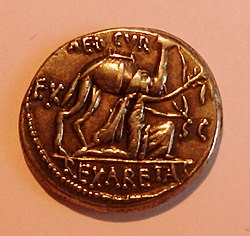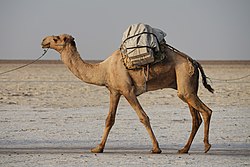Slab with Dromedary Rider from Tell Halaf
Größe:
1202 x 1799 Pixel (3287545 Bytes)
Beschreibung:
This relief was excavated in northern Syria at the site of Tell Halaf, the capital of a small independent city-state known as Guzana to the Assyrians, who conquered it in the late 9th century BC. More than two hundred such stone reliefs (called orthostats) decorated the façade of a temple-palace built in the 10th century BC by a local ruler named Kapara. He reused the blocks from one or more pre-existing structures and carved an inscription in cuneiform on each one that states, "Palace of Kapara, son of Hadianu." The blocks were placed so that limestone ones painted red alternated with others of black basalt. While the human images have been depicted in the less sophisticated, local style, many of the animal reliefs, such as the goat, may have been modeled on finely carved ivories imported from northern Syria and Phoenicia that were found at the site.
A rider perches atop the hump of a dromedary camel, urging it on with a staff. Crossed bands securely fasten the saddle onto the animal. The curving neck, rounded body, and unevenly placed hooves re-create the rocking sensation of a camel in motion. This image represents an Arabic caravan trader. From the beginning of the 1st millennium BC the domestication of dromedaries made the caravan trade possible. This relief from Guzana may be the earliest representation of such a dromedary rider. There are traces of King Kapara's inscription on the top edge of the stone.
Weitere Informationen zur Lizenz des Bildes finden Sie hier. Letzte Aktualisierung: Thu, 22 Sep 2022 06:15:03 GMT
Relevante Bilder
Relevante Artikel
Dromedarii
Als Dromedarii wurden auf Kamelen reitende Kavalleristen der Auxiliartruppen (Hilfstruppen) bezeichnet, die bevorzugt in den östlichen und südlichen Wüstenprovinzen des Römischen Reiches eingesetzt wurden. Der Begriff Dromedarius bedeutet „…jemand, der auf einem Kamel reitet“ oder schnell, geschickt". Er ist eng verwandt mit: Dromas, dromadis = Dromader, das einhöckrige Kamel. Sowohl arabische als auch nordafrikanische Nomaden domestizierten Kamele seit vielen Jahrhunderten. Es existierte daher eine lange Tradition der Nutzung als Last- und Reittiere, dies überwiegend in Nordafrika und den Ostprovinzen des Reiches. Die Einführung der Kamelreiterei in der römischen Armee geht wohl auch auf die aride Natur des Nahen Ostens sowie als Reaktion auf parthisch/persische Kampfmethoden und die Erfahrungen bei der Abwehr von Einfällen der Nomadenvölker zurück.
.. weiterlesen





